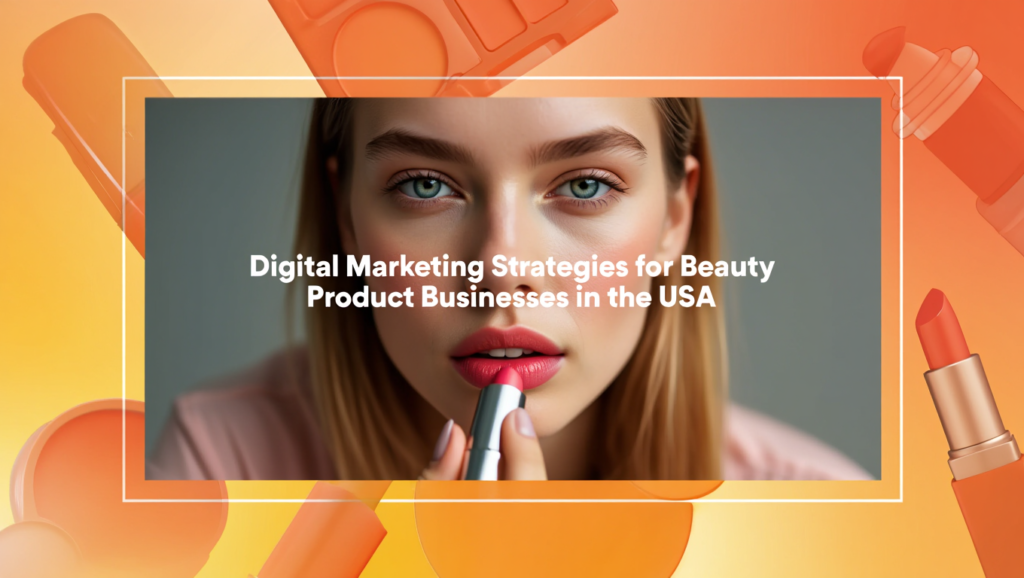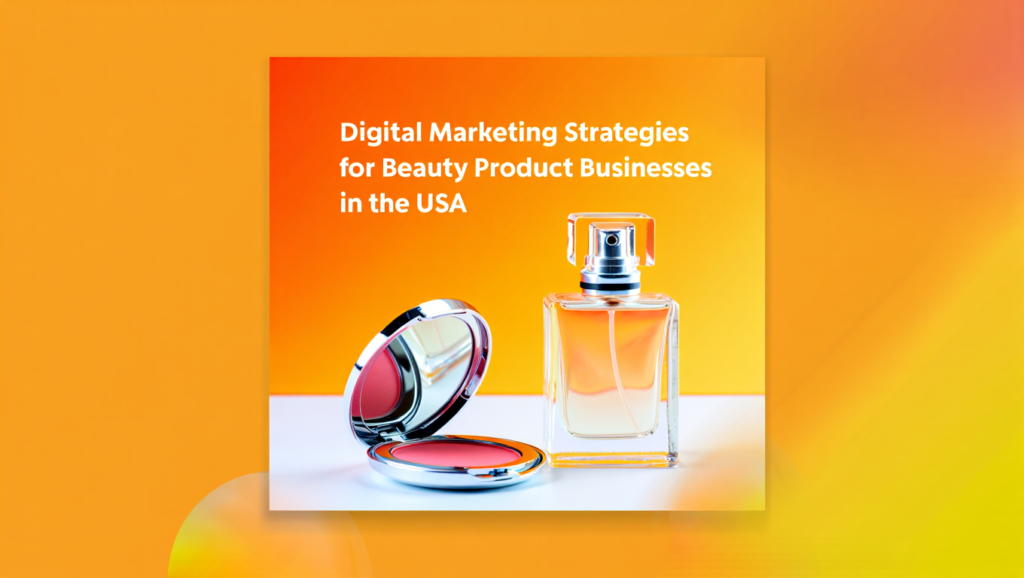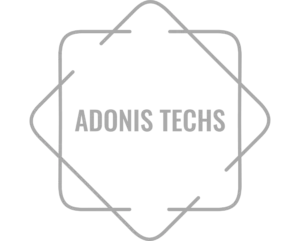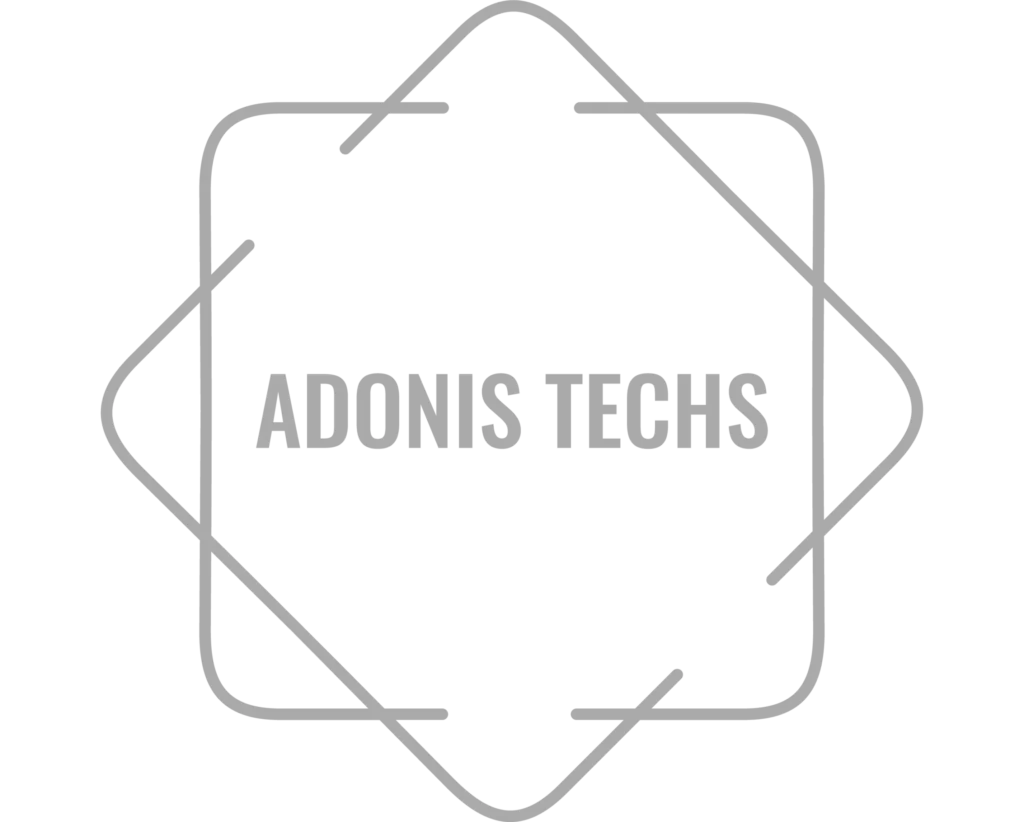The beauty industry in the United States is one of the fastest-growing markets, with skincare, cosmetics, and personal care products generating billions annually. Yet with growth comes fierce competition. From global luxury names to small independent skincare startups, every brand is fighting for consumer attention in a crowded digital space.

This is where digital marketing for beauty products USA becomes indispensable. In a world where consumers discover products through Instagram reels, YouTube tutorials, TikTok trends, and Google searches, having a strong online presence isn’t optional, it’s the foundation for long-term growth.
Traditional advertising once dominated the beauty industry, but consumer behavior has shifted dramatically. Customers no longer buy based on flashy TV ads or print campaigns alone. Instead, they research online reviews, watch influencer tutorials, compare prices on e-commerce sites, and search for “best skincare product for acne” before making a purchase. Without a strategic beauty brand online marketing plan, even high-quality products risk being overlooked.
This article explores actionable skincare and cosmetics marketing strategies designed for the U.S. market, covering everything from beauty product SEO and content creation to social media, paid ads, and email retention marketing. We’ll also highlight how working with the right partner, such as a trusted Houston marketing agency, can help beauty businesses stand out in a saturated market.
Understanding Consumer Behavior – How US Consumers Shop Online for Beauty and Skincare

The way American consumers shop for beauty products has completely transformed in the last decade. Instead of relying on in-store consultations, they now turn to digital platforms for inspiration, research, and purchasing decisions. This behavior shift is why digital marketing for beauty products USA is more important than ever.
Here are some key trends shaping buying habits:
- Search-Driven Decisions
Many consumers begin their journey on Google with queries like “best anti-aging cream,” “organic skincare brands USA,” or “top cosmetics for sensitive skin.” This makes beauty product SEO critical for visibility. If your product pages and blogs don’t rank, competitors will win the traffic and the sales. - Influencer & Peer Recommendations
Reviews and influencer content heavily influence beauty buyers. Whether it’s a dermatologist-backed video or a TikTok beauty hack, U.S. shoppers trust authentic voices over traditional ads. - Omnichannel Shopping
While e-commerce dominates, many still value physical stores. Shoppers often research products online and then buy in-store, or vice versa. This reinforces the need for consistent beauty brand online marketing across all platforms. - Skincare-Centric Growth
Skincare continues to outperform cosmetics in the U.S. market. Consumers see skincare as wellness-driven and science-backed, making skincare SEO strategies a must for brands wanting to capture this demand.
SEO for Beauty Products – Product Page Optimization, Long-Tail Keywords, Reviews
Search Engine Optimization (SEO) is one of the most effective skincare and cosmetics marketing strategies for driving sustainable traffic and sales. Unlike ads, SEO builds long-term visibility and trust.
1. Product Page Optimization
Each beauty product should have its own SEO-friendly page. This includes:
- Descriptive, keyword-rich product titles.
- Benefit-driven descriptions (“hydrating serum for dry skin” instead of just “hydrating serum”).
- High-quality images with alt tags optimized for beauty product SEO.
- User reviews and testimonials for trust and added keyword relevance.
2. Long-Tail Keywords for Buyer Intent
While broad terms like “skincare products” are competitive, long-tail keywords convert better. Examples include:
- “Best cruelty-free moisturizer USA”
- “Organic vitamin C serum for acne scars”
- “Dermatologist recommended sunscreen Houston”
Optimizing for these terms not only attracts more qualified buyers but also improves relevance for skincare SEO.
3. Leveraging Customer Reviews
Reviews are both a trust signal and an SEO asset. UGC (user-generated content) often contains natural keywords that boost rankings. For instance, a review that says “This serum is the best skincare product for acne-prone skin” directly supports your beauty product SEO.
4. Connecting SEO With Other Strategies
SEO doesn’t work in isolation, it integrates with content marketing and social campaigns. For example, our resource on social media marketing for beauty brands in the USA shows how social platforms drive awareness, which in turn improves branded search queries and organic visibility.
Social Media Marketing – Instagram, TikTok, YouTube Influencers, UGC
For beauty brands in the USA, social media is not just a marketing channel, it’s the primary way to reach, engage, and convert audiences. Platforms like Instagram, TikTok, and YouTube dominate the conversation around skincare and cosmetics. That’s why digital marketing for beauty products USA must include a strong, multi-platform social strategy.
Key Platforms for Beauty Brand Online Marketing
- Instagram
- Best for high-quality product visuals, stories, and influencer collaborations.
- Shoppable posts and reels make it easier for brands to turn inspiration into direct sales.
- TikTok
- The epicenter of viral beauty trends. Hashtags like #skincare, #beautytips, and #makeuptransformation generate millions of views.
- Short-form, authentic videos drive UGC and discovery, making TikTok crucial for skincare SEO and brand exposure.
- YouTube
- Perfect for long-form tutorials, unboxings, and dermatologist-backed advice.
- Builds authority and trust, key in beauty brand online marketing where credibility influences purchase decisions.
- Pinterest
- Often overlooked, Pinterest is powerful for evergreen content like beauty routines and product guides.
- Strong SEO integration means pins can drive traffic for years.
The Role of UGC (User-Generated Content)
Beauty buyers trust real users more than ads. Encouraging customers to post reviews, selfies, or transformation videos creates social proof and boosts organic reach. UGC also naturally incorporates keywords that support beauty product SEO strategies.
To see how social media ties into full-funnel strategies, check out Social Media Marketing for Beauty Brands in the USA, a guide that shows why social-first content is a game-changer.
Paid Ads for Beauty Brands – Google Shopping, Meta Ads, Influencer Collabs
While organic growth is crucial, paid advertising accelerates visibility and sales. For competitive markets like skincare and cosmetics, balancing paid and organic digital marketing ensures consistent results.
1. Google Shopping & Search Ads
- Ideal for consumers actively searching for products.
- Example: A shopper searching “buy retinol serum USA” sees product listings with images, prices, and reviews.
- Optimizing product feeds with beauty product SEO keywords ensures ads show up for high-intent queries.
2. Meta Ads (Facebook & Instagram)
- Enable hyper-targeting based on demographics, interests, and lookalike audiences.
- Visual-first creatives, carousel ads, and video reels work especially well for skincare and cosmetics marketing strategies.
3. Influencer Collaborations as Paid Media
- Sponsored posts with influencers combine trust with reach.
- Micro-influencers often outperform celebrities because their recommendations feel more authentic.
- This approach doubles as both beauty brand online marketing and paid amplification.
4. Cross-Promotion With Other Niches
Paid ads for beauty can also intersect with wellness and lifestyle. For instance, digital marketing for weight loss businesses shows similar strategies, emphasizing transformation stories and results, which can be adapted for skincare and cosmetics.
By combining paid ads with strong SEO and organic social, beauty brands can maximize reach while building long-term brand equity.
Content Marketing – Tutorials, Beauty Guides, Before/After Case Studies
Content is the fuel that powers modern digital marketing for beauty products USA. In the beauty industry, buyers want proof, education, and inspiration before they make a purchase. This makes content marketing an essential strategy for long-term growth.
Types of Content That Work for Beauty Brands
- Tutorials and How-To Videos
- Step-by-step guides on skincare routines or makeup looks.
- Boost brand credibility while subtly showcasing products.
- Beauty Guides & Educational Blogs
- Articles like “Best Skincare Routine for Oily Skin” or “Top Anti-Aging Ingredients” drive SEO traffic.
- Incorporating beauty product SEO keywords ensures higher visibility on Google.
- Before & After Case Studies
- Visual proof is powerful. Sharing client results builds trust.
- Works especially well in skincare SEO where customers search for proven solutions.
- Expert Interviews & Testimonials
- Featuring dermatologists, beauty experts, or influencers adds authority.
- Enhances both search rankings and consumer trust.
A great example of integrating content with broader campaigns can be seen in The Complete Guide to Digital Marketing for Healthcare Businesses in the USA. The same principle applies to beauty: high-value content positions your brand as the go-to authority.
E-commerce Optimization – Conversion-Focused Websites for Cosmetics
Your website is more than a digital storefront, it’s the centerpiece of your beauty brand online marketing. A well-optimized e-commerce site can drastically improve conversions and customer experience.
Key Elements of Beauty E-Commerce Optimization
- High-Quality Product Pages
- Clear product descriptions with skincare and cosmetics marketing strategies in mind.
- Rich visuals, videos, and user reviews that reassure buyers.
- Simplified Checkout Process
- Fewer clicks = fewer cart abandonments.
- Multiple payment options (PayPal, Apple Pay, Klarna) increase flexibility.
- Mobile-First Design
- A large percentage of beauty shopping happens on smartphones.
- Fast-loading, mobile-friendly pages also improve SEO.
- Personalized Shopping Experiences
- AI-powered recommendations (“You may also like…”) boost average order value.
- Helps position your site alongside global leaders in digital marketing for beauty products USA.
- Trust Signals
- Certifications, return policies, and social proof build credibility.
If you’re a brand based in Texas, partnering with a strong Houston marketing agency can help optimize your online store and integrate SEO, ads, and conversion-focused design.
Email & Retention Marketing – Building Loyalty Programs and Repeat Sales
While many beauty brands focus heavily on acquisition through digital marketing, retention is often where the real profits lie. Retaining existing customers costs significantly less than acquiring new ones, and with the right strategy, beauty businesses can build long-term loyalty.
Why Email Marketing Matters in Beauty
- Personalized Campaigns
- Sending skincare tips, personalized product recommendations, and seasonal offers makes customers feel valued.
- Using beauty product SEO insights, emails can align with what customers are searching for.
- Exclusive Loyalty Programs
- Points-based rewards or early access to new launches create repeat buyers.
- Great for brands that want to maximize skincare SEO keywords by promoting product-specific guides.
- Automated Follow-Ups
- Cart abandonment emails recover lost sales.
- Post-purchase check-ins encourage reviews and upsells.
- Educational Series
- A weekly skincare guide or beauty tutorial email adds value beyond promotions.
- Builds trust and positions your brand as an authority in skincare and cosmetics marketing strategies.
Measuring ROI in Beauty Marketing – Sales Tracking, CAC, and LTV
No digital marketing for beauty products USA campaign is complete without measuring results. Understanding where your money goes, and what it brings back, ensures that marketing strategies remain profitable.
Key Metrics Beauty Brands Should Track
- Customer Acquisition Cost (CAC)
- How much it costs to acquire a new customer via SEO, ads, or social campaigns.
- Lifetime Value (LTV)
- How much revenue an average customer brings over their entire relationship with your brand.
- A higher LTV means retention strategies are working.
- Return on Ad Spend (ROAS)
- For paid campaigns, this tells you how much revenue each dollar spent is generating.
- Organic Traffic & Conversions
- Tracking SEO-driven leads, especially from beauty product SEO and skincare SEO, reveals the true impact of content and search strategies.
- Engagement Metrics
- Email open rates, click-through rates, and social media engagement help refine content.
For many businesses, working with an experienced Houston marketing agency ensures accurate reporting and actionable insights, saving both time and budget.
Conclusion – Building a Winning Digital Marketing Strategy for Beauty Product Businesses in the USA
The beauty industry in the United States is evolving rapidly, and brands that fail to adapt risk falling behind. From SEO for beauty products and skincare SEO strategies to influencer-driven social campaigns and conversion-focused e-commerce design, every touchpoint matters. Consumers expect personalized experiences, educational content, and seamless online shopping journeys.
By combining beauty product SEO, strong content marketing, social media engagement, and data-driven paid campaigns, beauty brands can not only attract new customers but also retain them for long-term growth. Whether you are a skincare startup or an established cosmetics label, building a holistic digital presence is no longer optional, it is essential.
If you want to go beyond generic approaches and implement powerful skincare and cosmetics marketing strategies, partnering with an expert Houston marketing agency can make all the difference. At AdonisTechs, we specialize in digital marketing for beauty products USA, helping brands grow visibility, drive conversions, and build loyal communities.
Ready to Elevate Your Beauty Brand?
Contact AdonisTechs LLC today and discover how our tailored digital solutions can help your brand stand out in one of the most competitive industries in the world.



